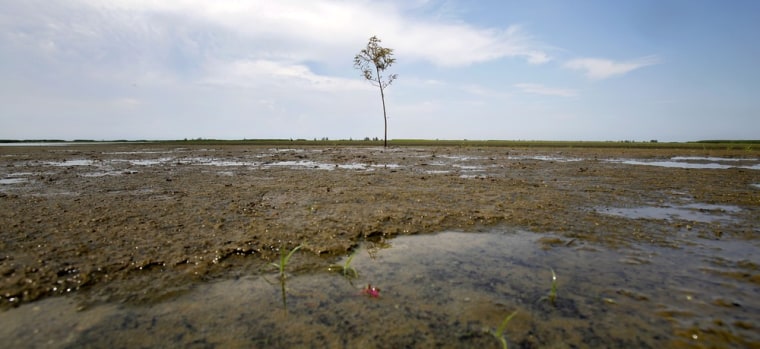In 2003, the Army Corps of Engineers cut a hole in the bank of the Mississippi River, miles from where the wending river ends its 2,320-mile journey to the Gulf of Mexico. The idea was simple: let the river run wild through the gap, and silt-laden waters would naturally do what they've done for thousands of years: build up new land.
Then the people waited. And waited. But nothing happened and no land was gained.
Finally, something changed this year. Scientists say historic flooding on the river — coupled with recent work by the Army Corps to build artificial islands at the edge of the bay — have produced a hump of land in an area called West Bay. The new plug of terra firma measures about 4 acres.
It's a small plot — "picayune" for Louisiana's French-Cajun country — but it's giving scientists cause for hope. This new mud island could have huge strategic implications in the fight to stop a fragile, eroding coast from vanishing faster than it already is.
G. Paul Kemp, a Louisiana coastal scientist with the National Audubon Society, splashed onto the new patch of land and plunged his hand into the dark, muddy earth. Pink-plumed birds called roseate spoonbills flew overhead and big, leafy American lotuses glistened on a distant bank.
"This is what the river likes to do, if we don't get in the way," Kemp said of the new high ground. "What was going on here was a gradual loss of land, and that has been reversed. I can't imagine a more important lesson."
Coastal Louisiana, which sits atop the 7,000-year-old Mississippi delta, has lost about 1,900 square miles of land since the 1930s. The delta has been shredded by development — logging and oil drilling — and levees have starved these wetlands of the Mississippi sediment and freshwater that gave birth to the Louisiana delta over its short geologic history.
The 4 acres of new land in West Bay reveal both new and old lessons.
Scientists have known for years that when the river flows free of its banks, in a phenomenon called a crevasse, land forms.

A 1987 study found that 114 square miles of land was formed by a crevasse that opened between 1839 and 1932 near West Bay and another one, nearby Cubit's gap, created 74 square miles between 1862 and 1946. So, the 4 acres growing from this new manmade cut proves the river can still build land.
For now, scientists hope to learn if there's a way to slow the catastrophic land loss with more diversions. Their aim: to help stop some 17 square miles of wetlands from being gobbled up each year.
Alex Kolker, a coastal geologist at Louisiana Universities Marine Consortium, stood nearby on the recent outing with Kemp and studied a chunk of the new land, freshly dug up with a shovel.
"This is a classical river deposit," he said eagerly.
He pointed to the layering of sediments — blackened by microbes and slimy with green algae — brought in by the floodwaters which raged this year when the river saw flood stages that rivaled those of the Great Mississippi Flood of 1927.
"This is very small scale in terms of what is needed coast wide. We need to use it as a learning opportunity," Kolker said.
The river cut made at West Bay has opened the floodgates of scientific debate. The crux of the matter: will diverting Mississippi River water build up enough land to help blunt coastal erosion over the long term?
One new scientific paper argues that such river diversions do far more harm than good and actually causes land loss because the Mississippi's waters contain too many nutrients for Louisiana's salt marsh environment. Other scientists wonder if they will build land fast enough and whether the nation can afford it. The West Bay project has cost about $31 million.
It's no mere academic debate.
Since Hurricane Katrina devastated New Orleans six years ago, exposing the delta's extreme vulnerability to sea level rise and hurricanes, efforts to develop a long-term plan to protect southern Louisiana have intensified.
Scientists warn that southern Louisiana's coasts could erode away unless the nation spends billions of dollars on shoring up its coast.
The federal government is working with scientists and state leaders to draft plans on how to best deal with land loss. Just this month, the Army Corps and the state officials announced a $25 million plan to study the Mississippi's water flow and devise a delta-management master plan.
Meanwhile, President Barack Obama's administration has set up a panel led by Environmental Protection Agency head Lisa Jackson to develop a restoration plan. It's counting on using the billions of dollars in fines expected to be paid by energy giant BP PLC for the catastrophic oil spill off Louisiana's coast last year.
All of these plans envision diverting sediment and freshwater from the Mississippi into the delta region. Doing so would build on two decades of work by the Army Corps and state engineers to build diversions, some of them complex manmade structures and others simple levee cuts like the one at West Bay.
The consensus is that diverting the river undoes the damage of the Army Corps' historic work spanning decades.
The Mississippi carries huge amounts of sediment and silt from the heartland. For thousands of years, spring floods carried that mud across the low plains of Louisiana, building today's delta bit by bit — much as other river deltas around the world form.
Starting in the early 1900s, crews began building levees and closing off ancient outlets to the Gulf. That in turn starved the delta of sediment and freshwater, prompting the land to begin sinking and erosion to start.
Re-engineering the river so it can begin forming land again sounds good, but the debate remains fierce because there's a lot of evidence that diversions don't work.
"The amount of sediment coming down the Mississippi is far less than what it was in the past," said Robert Dalrymple, a Johns Hopkins University coastal engineer and member of a National Research Council committee studying Louisiana's dilemma. "The problem is you need sediment to build land. I worry that they're not providing enough sediment. They certainly work, but it's the vastness of the problem."
The river carries about half as much sediment as it did in the 1800s. Soil conservation practices, upriver dams and levees all contribute to the lower dirt load.
When the Army Corps cut the bank at West Bay in 2003, the agency said it expected 9,831 acres of marsh to be created over 20 years. In its first 10 years, the river cut has barely made a dent in that goal, perhaps in part because the corps did not build the artificial islands until 2009.
And a new paper in the Geophysical Research Letters cast even more doubts on river diversions.
The study looked at how much land three diversions had built over their 19 years of life — between 1984 and 2005 — and found they'd done nothing to build land and had actually caused interior wetlands to erode.
In one case, the Caernarvon diversion south of New Orleans, the researchers said the diversion caused about 55 square miles of land loss because the Mississippi's waters weakened marsh plants and led to an explosion of unwanted plant life such as Chinese tallow trees and hyacinth.
"When you lose 55 square miles of land for a project that took 19 years, and you thought it was an absolute success at the beginning, it's time to take a deep breath ... and figure out what went wrong before you spend billions of dollars on similar projects," said R. Eugene Turner, a coastal expert at Louisiana State University who worked on the study.
Turner calculates that at current spending rates it costs about $177,000 per acre of restored land in coastal Louisiana, or about $113 million per square mile.
Michael Kearney, a coastal scientist at the University of Maryland and lead researcher on the new paper, said diversions like West Bay might work because they are close to the Gulf. But he said diverting the river farther inland — something many scientists propose — would hurt more of the delta's interior marshland just as what happened at Caernarvon.
But others look at the 4 acres created at West Bay as proof of something useful.
At West Bay, Michael Poirrier of the University of New Orleans walked across the new land and pondered the delta's plight.
"To actually stand here on ground that wasn't here a year or so ago, that's special," he said. "This is hard ground."
But he paused and thought about the thousands of years it took to build up the delta and what role small-scale projects might have in arresting the loss of wetlands today.
"Whether or not we can restore all of coastal Louisiana to the way it was with diversions is another thing," he said. "Can we prevent further land loss? Yeah, maybe not 100 percent, but we can certainly slow it down."
